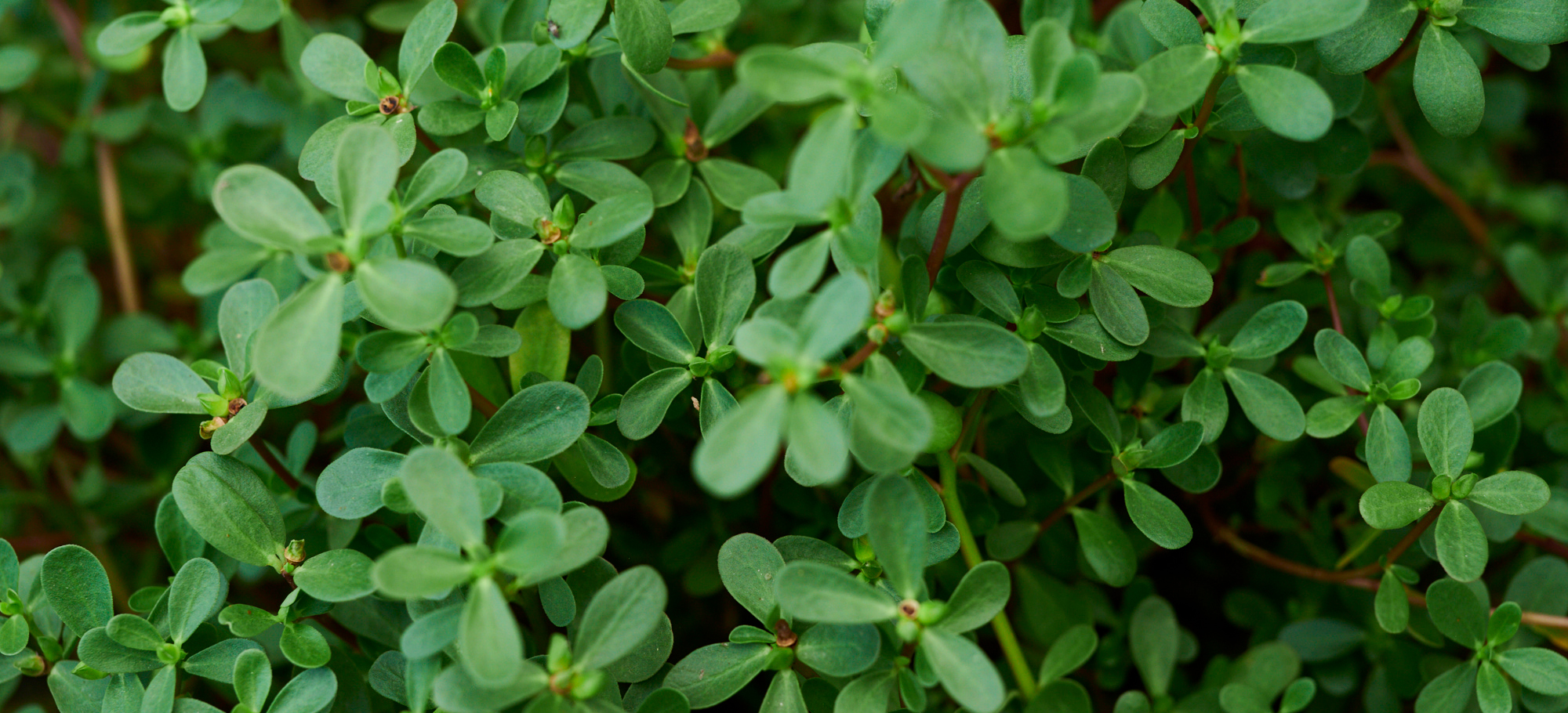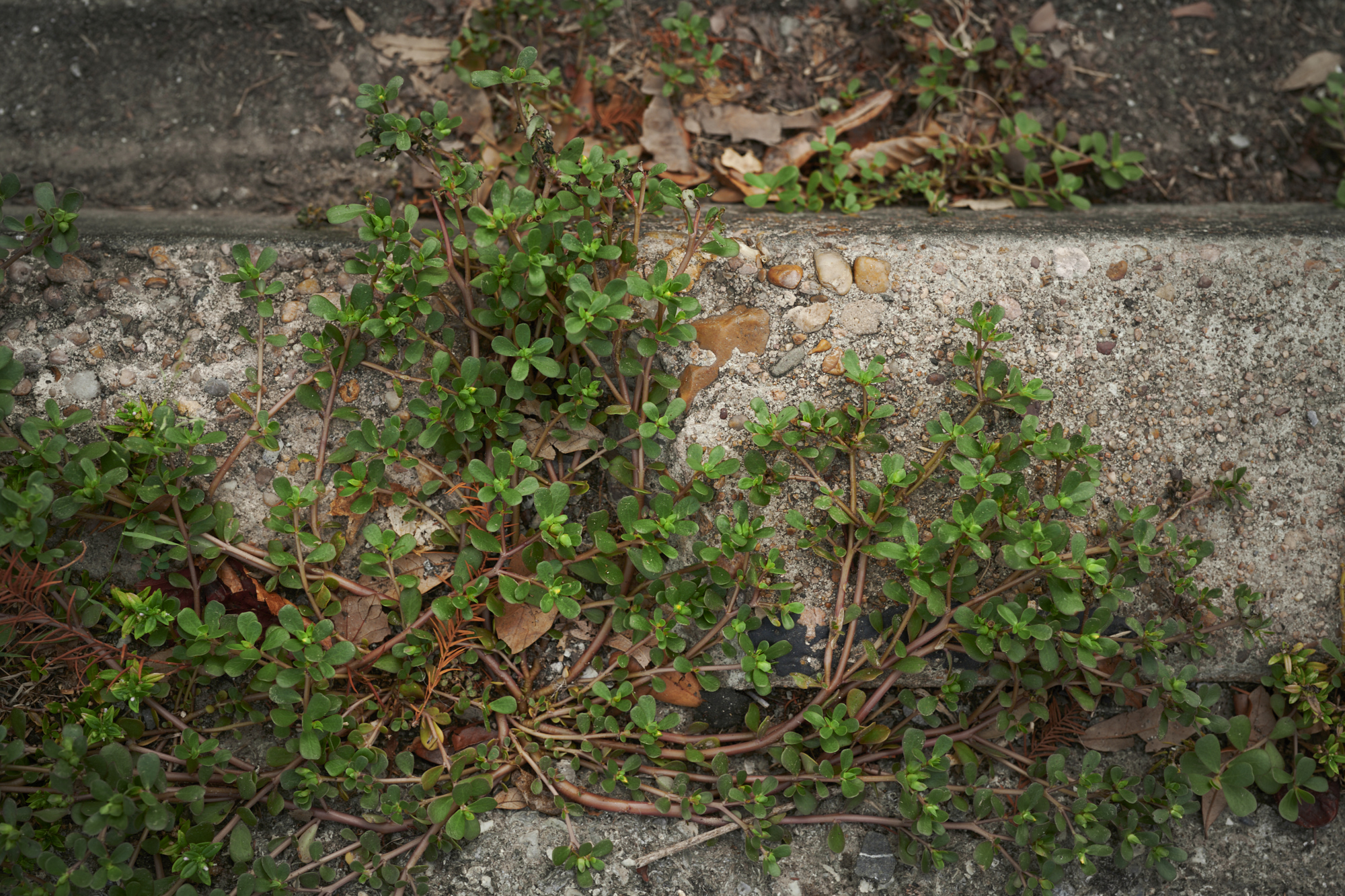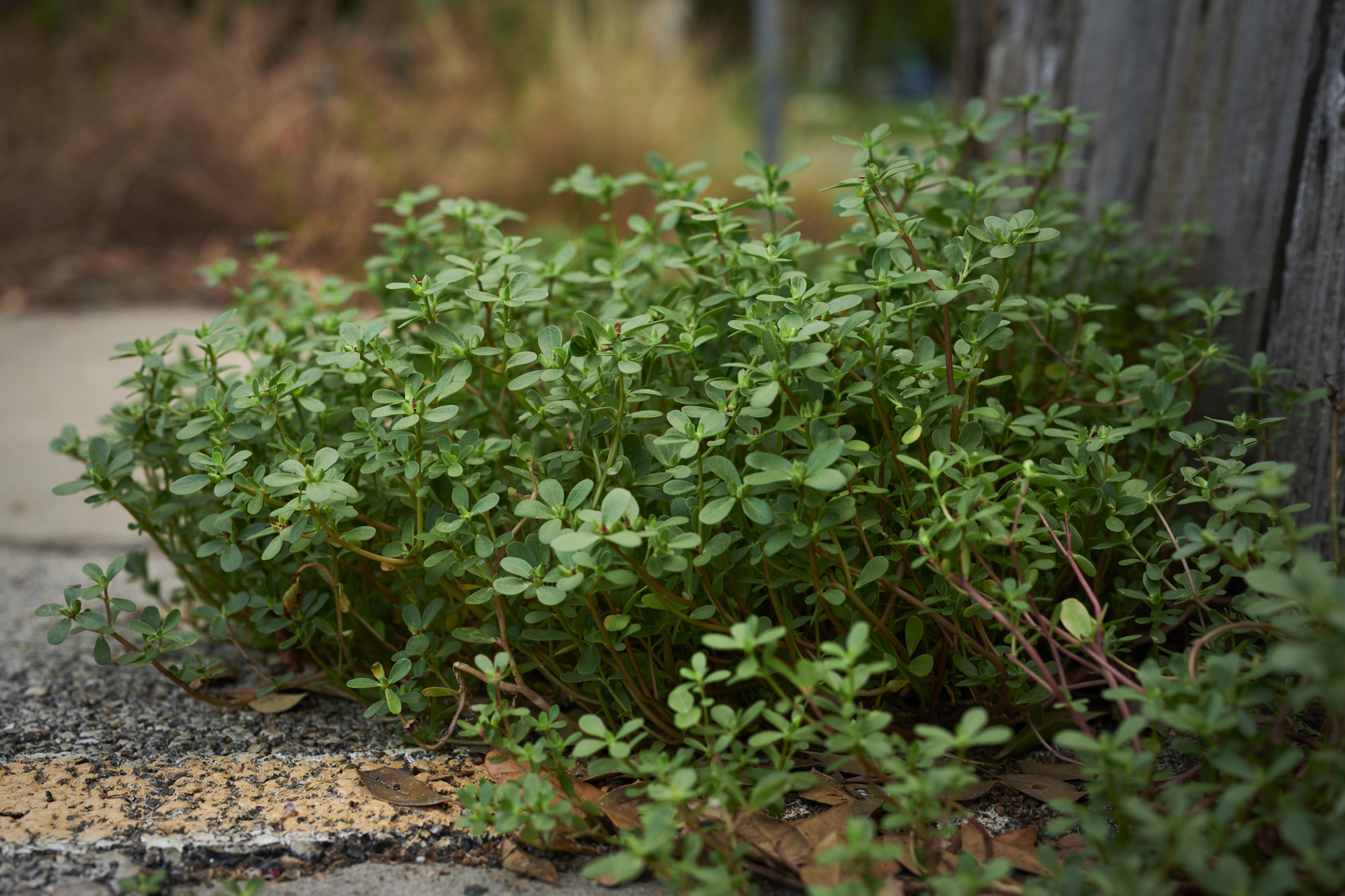Viriditas: Musings on Magical Plants
Portulaca oleracea
Originally published in Issue 28 of Plantings: The Journal of the World Sensorium/Conservancy

Excruciating, unprecedented, endless, hellscape: these are some of the words that have been used to describe Houston, Texas this summer as it roasts under a heat dome with record temperatures and extreme drought. While those of us who are able and without roots seek shade and water, much of the usually lush plant life is dead. But sprawling forth from the cracks in the concrete, one little plant is thriving under the scorching sun. Portulaca oleracea, or common purslane, is a resilient succulent with fleshy green leaves and rusty red stems. Radiating outward from a single taproot, purslane adapts to almost any soil and can withstand periods of drought. With adequate rainfall, P. oleracea is bespeckled with little yellow flowers that produce ovoid fruits holding tiny black seeds. Happily gracing unassuming places like sidewalks, roadsides, and parched fields, purslane is often underfoot but rarely acknowledged. Though maligned as a weed by some, purslane is a powerhouse of nutrition, medicine, and magic.

P. oleracea is beloved by cultures across the globe and utilized by many traditional medicine systems. Characterized as cooling and moistening, it has anti-inflammatory, antioxidant, antimicrobial, and neuroprotective properties. It soothes coughs, relaxes muscles, aids in wound healing, and lowers cholesterol.1 Known as ma-chi-xian in Chinese, purslane is considered a long-life vegetable praised for its ability to clear heat, resolve toxicity, and ease the intestines.2 Dioscorides shares this assessment, recommending purslane for headaches, inflammation, burning conditions, wounds, and intestinal worms. He also notes that purslane is an anaphrodisiac which “dissolves the hot desire to sexual union.”3 Ibn-Sina echoes this, adding that excessive use may also cause day-blindness.4 Gerard’s Herball and Parkinson’s Theatrum botanicum, sing the same praises of purslane, but Parkinson spices things up a bit, sharing that purslane “juyce also is used with oyle of Roses . . . for blastings by lightening, or planets, and for burnings by Gunpowder, or other wise, as also for womens sore breasts.”5 Surprisingly, Hildegard isn’t a fan, holding that cold, mucus producing purslane “is not profitable for a person to eat.”6 You can’t win them all.

Purslane is not classically witchy. It flies, for the most part, under the occult radar. It doesn’t have the bite of the baneful herbs brandished in popular media, nor does it have the mass appeal of the kitchen herbs, but it does have a solid and curious magical history making it more than deserving of a second glance on the sidewalk. P. oleracea is commonly aligned with the moon. Lunar herbs are often moist, juicy, succulent, and sometimes salty. Purslane is all these things. In Sylva Sylvarum, Francis Bacon notes, “The Influences of the Moon (most observed) are four; the drawing forth of Heat; the Inducing of Putrefaction; the increase of Moisture; the exciting of the Motions of Spirits.”7 This nicely reflects purslane’s medicinal classification as a cooling and moistening herb used to clear heat. Similarly, purslane’s lunar signature may also be seen in Ibn-Sina’s concern that overuse could induce day blindness, or the inability to see clearly by the light of the sun.
The moon governs the night, sleep, and dreams. Purslane was historically worked with to induce sleep and protect dreamers. Ficino includes purslane in a recipe to bring sleep to the sleepless, instructing to “Strew their beds with the leaves of cold plants. Soothe their ears with low songs and sounds. Often moisten their heads with these baths, namely water in which the following have been boiled: bits of poppy; lettuce; purslain; mallows; and leaves of roses, of grapevine, of willow, and of reeds; with the addition of camomile.”8 Interestingly, this is not the only time purslane appears between the sheets. Writing well after Ficino, occult herbalist Paul Sédir notes that when placed in bed, purslane prevents the sleeper from having visions.9 Additionally, Richard Folkard shares how the same practice was “in olden times [...] considered a sure protection against evil spirits.”10

One of the earliest magical references to purslane is found within the Greek Magical Papyri, in a section translating the cryptonyms used by scribes in sacred writings to hide the identities of herbs from the masses. Purslane’s codename is revealed to be “Blood of Ares,” and Ares, the dreaded Greek god of war akin to the fiery Roman god Mars, is quite unlike the cool, watery moon.11 Yet perhaps you only receive the name Blood of Ares if you are fierce enough to survive on the burning pavement during a Houston summer. Intriguingly, purslane’s survival instinct emerges under the moonlight. Purslane’s specialized physiology enables it to thrive in hot, dry conditions by switching from daytime C4 photosynthesis to nighttime CAM crassulacean acid metabolism.12 During CAM photosynthesis, in an effort to conserve moisture, purslane only opens its stomata to trap carbon dioxide at night. The carbon dioxide is converted first into malic acid and then during daylight into glucose for storage. This allows the plant to retain its water in the harshest circumstances.
From a nutritional standpoint, purslane packs a sour punch. The presence of malic acid gives it a distinct tart flavor and it contains a wide variety of essential proteins, antioxidants, and metabolites that support everyday health.13 More specifically, purslane offers particularly high concentrations of potassium, magnesium, and calcium, as well as generous amounts of many other beneficial nutrients.14 Purslane is also a considerable herbal rarity as it’s an excellent source for immune-boosting omega-3 fatty acids that are typically only found in fish oil.15 While some of the early herbal texts privilege purslane seeds over the greens, the entire plant is edible and I love the juicy tang of fresh purslane leaves in the summer. If you can gently pinch the stem off with your fingers, it is also tender enough to eat raw with the leaves. The older stems may be fibrous, but they cook nicely. As with okra, purslane is mucilaginous and may become slimy when heated. If you aren’t a fan of gooey greens, I recommend enjoying purslane in salads or as a garnish.

When it’s sweltering out, one of my favorite ways to eat purslane is in watermelon salad with salty feta, crunchy cucumbers, and fresh herbs. Simply chop the watermelon and cucumbers and place them in a large bowl. Add crumbled feta and torn herbs like basil and mint, along with a handful of purslane greens. To make the dressing, whisk good quality olive oil, lime juice, and salt in a small bowl and then drizzle it over the salad and gently toss. It’s a quick and flexible recipe that can be altered to taste. You can substitute stone fruit like nectarines or cherries for the melon, chevre could stand in for feta, and radish and red onion would be nice additions.
Sadly, there can be too much of a good thing. Like spinach and sorrel, purslane contains oxalic acid, which can impede your body’s ability to absorb nutrients and increase the likelihood of kidney stones. To minimize these risks, I keep my portions on the smaller side and enjoy purslane with calcium rich foods, which bind to oxalates during digestion. Or if the taste of purslane is just not your thing, you can always take a cue from Pliny who attests that purslane’s beneficial properties are magically transferable by wearing the plant as an amulet around your neck.16
1 V Ghorani, S Saadat, MR Khazdair, Z Gholamnezhad, H El-Seedi, MH Boskabady. “Phytochemical Characteristics and Anti-Inflammatory, Immunoregulatory, and Antioxidant Effects of Portulaca oleracea L.: A Comprehensive Review.” Evidence-based Complementary and Alternative Medicine : eCAM, 2023, 2075444. https://doi.org/10.1155/2023/2075444
2 Chinese Herbal Medicine. Materia Medica, trans. Dan Bensky, Steven Clavey, and Erich Stöger, 3rd ed. (Seattle: Eastland Press, 2004) 191-3.
3 Dioscorides Pedanius, T. A. Osbaldeston, and R. P. A. Wood, De Materia Medica: Being an Herbal with Many Other Medicinal Materials: Written in Greek in the First Century of the Common Era: a New Indexed Version in Modern English (Johannesburg: IBIDIS, 2000), 272-5.
4 Ibn-Sina, Canon of Medicine Book II: Materia Medica, trans. Department of Islamic Studies Hamdard University. (New Dheli: Jamia Hamdard Printing Press, 1998), accessed Sep 15, 2023, https://www.naimh.com/_files/ugd/ee530d_32edca193e5e4e039a0a2e27171c2a65.pdf.
5 John Parkinson, Theatrum Botanicum: the Theater of Plants. Or an Universall and Compleate Herball, (London: Tho. Cotes, 1640) 722-4.
6 Hildegard Von Bingen, Hildegard Von Bingen's Physica: The Complete English Translation of Her Classic Work on Health and Healing, trans. Priscilla Throop, (Rochester: Healing Arts Press, 1998) 44.
7 Francis Bacon, Sylva Sylvarum: Or, A Natural History in Ten Centuries, (London: William Rawley D.D., 1683) 192, https://dlc.mpg.de/fulltext/-/226/.
8 Carol V. Kaske and John R. Clark, eds. trans., Marsilio Ficino / Three books on life; A Critical Edition and Translation with Introduction and Notes, (Binghamton: Center for Medieval and Early Renaissance Studies, State University of New York at Binghamton, 1989) 157-8.
9 Paul Sédir, Les Plantes Magiques, (Paris: Chacornac, 1902) 165.
10 Richard Folkard, Plant Lore, Legends, and Lyrics : Embracing the Myths, Traditions, Superstitions, and Folk-lore of the Plant Kingdom, (London: S. Low, Marston, Searle, and Rivington, 1884) 508.
11 Hans Dieter Betz, ed. The Greek Magical Papyri in Translation, Including the Demotic Spells, (Chicago: University of Chicago Press, 1986) 168.
12 R.C. Ferrari, B.C. Cruz, V.D. Gastaldi, et al. “Exploring C4–CAM plasticity within the Portulaca oleracea complex.” Scientific Reports 10, 14237 (2020). https://doi.org/10.1038/s41598-020-71012-y
13 A Kumar, S Sreedharan, A.K. Kashyap, P Singh, N Ramchiary, “A review on bioactive phytochemicals and ethnopharmacological potential of purslane (Portulaca oleracea L.)” Heliyon, 8 (Jan 2021) https://doi.org/10.1016/j.heliyon.2021.e08669
14 M.K. Uddin, A.S. Juraimi, M.S. Hossain, M.A. Nahar, M.E. Ali, M.M. Rahman, “Purslane weed (Portulaca oleracea): a prospective plant source of nutrition, omega-3 fatty acid, and antioxidant attributes.” The Scientific World Journal, (2014), 951019. https://doi.org/10.1155/2014/951019
15 Y.X. Zhou, H.L. Xin, K. Rahman, S.J. Wang, C. Peng, H. Zhang, “Portulaca oleracea L.: a review of phytochemistry and pharmacological effects” BioMed Research International, (2015), 925631. https://doi.org/10.1155/2015/925631
16 Pliny the Elder, The Natural History of Pliny, John Bostock and H.T. Riley, trans, (London: Taylor and Francis, 1855) Book XX ch. 81, https://www.gutenberg.org/files/57493/57493-h/57493-h.htm
